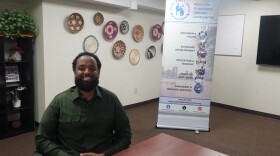Two years ago Frank Wucinski and his then 3-year-old daughter Annabell were among those evacuated from Wuhan, China and put into federal quarantine at Marine Corps Air Station (MCAS) Miramar.
"It was a good thing we did that," Wucinski said in Feb. 2020 while waiting for test results in the hospital. "But on the other hand there’s this feeling of guilt that I’ve left my wife during the toughest part of her life."
Wucinski’s wife, Li Qiong, had to stay in China. The two week quarantine, which included a hospital visit, was not easy on their daughter Annabell.
"In her mind it’s mommy not wanting to see her," Wucinski said while under quarantine. "So she’s been kinda saying things like, 'I don’t want to talk to mommy.' [You] just kind of explain it as simply as you can: Mommy misses you and mommy loves you."
RELATED: Father, Daughter Negative For Coronavirus; Back In Quarantine At Miramar
The dad and daughter were flown into San Diego on unmarked white planes, some of more than 200 Americans and their families quarantined inside base hotel rooms. For San Diegans it was their first local experience with the coronavirus.
"I think most people were just confused and trying to understand what is this all about?" said former San Diego County Supervisor's Chair Greg Cox.
Cox, now retired, was chairman of the board in 2020. He said he was not sure what to expect.
"It’s one of these things you’re kind of figuring, 'Well, is this just a passing problem?' We had problems with Swine Flu, with H1N1, Ebola — those were just kind of blips on the radar screen," Cox said. "People were kind of following what was going on but for the most part it never impacted their lives and now this was something that looked like it was potentially going to be much bigger and, as it turned out, it certainly was."
RELATED: Plane From China Expected To Arrive At MCAS Miramar
If anyone got sick at Miramar, they were not allowed to stay at the base. San Diego County’s Chief Medical Officer Dr. Eric McDonald was in-charge of figuring out care locally.
"We knew it was a big deal because this was something that had not been done in 50 years — literally — large scale federal quarantines," McDonald said. "What I remember was when we first got the call that San Diego might be a location and I was thinking, 'Why us?' And then I was trying to think, 'How can we get out of this?' But then we quickly figured out 'oh no this is where it’s going to be.'"
RELATED: What Life Is Like Inside Miramar's Coronavirus Quarantine
McDonald ended up asking UC San Diego Health and Rady Children’s Hospital to be ready if anyone felt sick. Back then test samples had to be sent to the CDC lab in Atlanta which took a few days for results.
"Really the heavy burden of what to do in terms of management fell on UCSD and Rady Children's Hospital to figure out the infection control," McDonald said.
Seven patients were ultimately taken to UCSD and Rady Children's Hospital. Officials remember the scene when the first patients arrived — they were given a police escort and were flanked by CDC officials. Of those seven that developed symptoms, two tested positive. They were the 13th and 14th cases of COVID-19 in the United States.
"You assume the worst — that it’s the most contagious and you work down from there," McDonald said.
UC San Diego Health's medical director for infection prevention and clinical epidemiology, Dr. Francesca Torriani, helped coordinate care for patients.
"You know you could see really the worry of some of being not welcomed and of really being afraid," Torriani said.
Torriani said a volunteer team of specialists was assembled. The group knew it was a respiratory virus, but were unclear how easily it could spread. So the patients were put inside special negative pressure rooms developed for contagious Ebola patients.
"We were at the maximum containment for all of these patients," Torriani said.
The safety protocols worked, no staff members ended up contracting the virus. While one patient did have an experimental treatment, everyone was discharged from hospital. All the evacuees ended up leaving the base before March came and we started seeing cases among local residents. McDonald said there were some valuable lessons learned during the federal quarantine, like how to safely transport COVID-19 positive patients.
"So I got our prehospital system geared up to handle that," McDonald said. "All the way to just the logistics of how to support a lot of people in one places who are on quarantine with food, with housing and with social services support."
Torriani said for some of the patients there was a language barrier, but she was focused on making them feel welcome so far away from home.
"Asking them what kind of food do they want, that would help them," Torriani said. "Giving them hot water and a teapot so that they could find some humanity — that was so touching and so important to make them feel less afraid."
During the quarantine period, the San Diego community showed their support. Military spouses organized food, toy and book donations while some local schools sent in Valentine's Day cards.
This early COVID-19 experience helped prepare San Diego officials when just a few weeks later cruise ship passengers had to be quarantined, and then unsheltered residents were isolated at the convention center.






